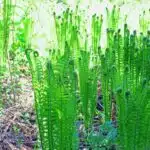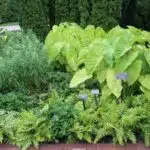When it comes to landscaping, planting under trees can pose a challenge for many gardeners. The lack of sunlight and competition for water and nutrients can hinder the growth of plants. However, there are some species of plants that thrive under trees and can add depth and beauty to any landscape.
Choosing the right plants for this specific setting requires careful consideration of their adaptability to low light conditions, tolerance for root competition, and ability to coexist with the tree without causing harm. In this article, we will explore some options of plants that not only survive but also thrive under trees, providing both aesthetic appeal and ecological benefits to your garden.
The Challenges Of Planting Under Trees
Planting under trees can be a challenging task due to the competition for resources between the tree and any plants placed beneath it. Roots from the tree can absorb much of the water and nutrients in the soil, leaving little for other plants. This root competition is further compounded by the fact that trees often create a dense canopy that blocks out sunlight, making it difficult for plants to photosynthesize.
Another challenge when planting under trees is soil quality. The soil beneath trees tends to be dry and lacking in nutrients. Leaves from the tree fall and decompose on top of the soil, creating a layer of acidic leaf litter that can make it difficult for other plants to grow. Additionally, roots from the tree can cause soil compaction, reducing air exchange and making it even more difficult for plants to thrive.
Despite these challenges, there are strategies that can be employed for successful planting under trees. One such strategy is mulching with organic materials like wood chips or leaves. Mulch helps retain moisture in the soil and provides a slow release of nutrients as it decomposes. Another strategy is to choose plant species that are adapted to growing in shade and have shallow root systems that won’t compete with those of the tree. By employing these strategies, it is possible to create a thriving garden under a tree canopy.
To successfully plant under trees, it’s important to consider factors such as light availability, moisture levels, and temperature fluctuations when choosing which species will thrive in this environment.
Factors To Consider When Choosing Plants
Soil conditions should be taken into account when selecting plants that thrive under trees as different types of soil require different levels of drainage and pH balance. Sun requirements must also be considered as some plants prefer full sun while others do better in partial shade. It is important to select a plant whose water needs match the area to ensure that it receives adequate moisture. Additionally, the nutrient needs of the plant should be addressed with the use of fertilizers or compost, as needed.
Soil Conditions
When choosing plants that thrive under trees, one of the most important factors to consider is the soil conditions. Soil pH and nutrient levels are crucial in determining which plants will grow well in this environment. It is essential to understand that trees absorb a significant amount of nutrients from the soil, which can affect the overall health of other plants growing underneath them.
The first thing to consider when dealing with soil conditions is the pH level. Most plants require a slightly acidic soil, with a pH range between 6.0 and 7.0. However, some species can tolerate more alkaline soils, up to a pH of 8.5. Testing your soil’s pH level will help you determine which plants are best suited for your specific location.
In addition to pH levels, it is also important to consider nutrient levels in the soil. Trees take up many of the nutrients necessary for plant growth, leaving less available for other plants growing underneath them. Therefore, it is crucial to choose plants that are adapted to low-nutrient environments or amend the soil with organic matter such as compost or mulch regularly. Properly understanding and managing these two factors – Soil pH and nutrient levels – will help ensure that your chosen plants thrive under trees’ canopy without competing for vital resources with their host trees or other nearby flora.
Sun Requirements
When it comes to planting under trees, one of the crucial factors to consider is sun requirements. Trees’ canopy can create partial shade or dappled sunlight, which can significantly affect the growth and health of plants growing underneath. Finding the right balance between light and shade is essential for selecting appropriate plants that will thrive in this environment.
Partial shade refers to areas that receive two to four hours of direct sunlight daily, while dappled sunlight occurs when trees filter light through their foliage, creating a shifting pattern of light and shadow on the ground. Plants that require full sun may not do well in these conditions, so it’s vital to choose species that are adapted to low-light environments.
When choosing plants based on sun requirements, it’s also essential to consider soil acidity and moisture levels. Different plant species have varying pH preferences and water needs, so selecting plants that match your soil’s natural conditions will help ensure their success. Testing your soil’s pH level and understanding its moisture-holding capacity will guide you in selecting plants that are well-suited for growing under trees without competition for resources with other flora nearby.
Shade-Loving Plants
Factors to consider when choosing plants for your landscaping project are numerous. You must take into account the climate, soil type, and sun exposure of your planting location. But what about those areas in your yard that receive less light because they are shaded by trees? Fear not, as there are many shade-loving plants that thrive under trees.
Shade-loving plants can be a great addition to your landscaping project. They add depth and texture to areas of your yard that otherwise may have been overlooked. Container gardening is a great way to incorporate these shade-loving plants into your design. Containers allow you to move the plants around, which is especially helpful if you have large trees with roots close to the surface of the ground. Vertical gardening is another option that can help maximize space and add visual appeal.
When incorporating shade-loving plants into your landscaping project, it’s important to choose varieties that are well-suited for your specific location. Consider factors such as the amount of sunlight or moisture present in the area. Here are five examples of shade-loving plants that thrive under trees:
- Hostas
- Impatiens
- Ferns
- Bleeding Hearts
- Astilbes
These plants not only look beautiful but can also help suppress weeds and regulate soil temperature. Incorporating ground covers like creeping phlox or periwinkle around these plantings can enhance their aesthetic appeal while also providing additional benefits like erosion control.
As you explore the world of shade-loving plants and container or vertical gardening, remember to keep in mind the specific needs of each plant and how it will fit into your overall design plan. With some careful planning and attention, you can create a stunning landscape even in areas with limited sunlight. Ground covers offer yet another option for beautifying shady areas while also providing practical benefits such as weed suppression and soil temperature regulation.
Ground Covers
Ground Covers:
Ground covers are an excellent choice for landscaping around trees. These low-growing plants not only add aesthetic appeal to the area, but also serve several functional purposes. Ground covers help in soil retention, reduce erosion, and suppress weed growth. They can also improve soil quality by adding organic matter upon decomposition.
Mulching techniques play a significant role in maintaining ground covers. Mulch helps retain moisture and nutrients in the soil while preventing weed growth. It is essential to avoid piling mulch against the tree bark, which may cause rotting or encourage pests and diseases. Instead, maintain a consistent layer of 2-3 inches deep around the ground covers.
Companion planting strategies can enhance the benefits of ground covers when planted alongside other species that complement each other’s growth requirements. For example, ferns are an excellent companion for many ground cover species as they thrive under similar conditions of shade and moist soils. Ferns’ delicate foliage adds texture and height to the landscape while providing a natural habitat for beneficial insects.
Transition into subsequent section:
By incorporating ferns into your landscaping design alongside ground covers, you can create a lush green space with varying textures and heights that require minimal maintenance. In the following section, we will discuss how ferns can be used as an ideal option for landscaping under trees.
Ferns
Ferns are a category of plant that are typically found in shady, moist environments, and are most commonly found beneath trees. There are many varieties of ferns, each with their own unique characteristics and requirements for care. Ferns typically require regular watering, as well as consistent exposure to indirect sunlight for optimal growth. For landscaping purposes, it is important to select the correct variety of fern for the environment and climate, as some varieties may not thrive in certain locations.
Types Of Ferns
Ferns are a versatile plant variety that can grow in various locations, including under trees. Fern varieties are known for their ability to thrive in shady areas, making them perfect additions to gardens or landscaping projects. If you’re new to gardening and looking to add some greenery beneath your trees, ferns are a fantastic choice.
When it comes to choosing the best fern varieties for planting under trees, there are several options available. The Christmas fern is a popular choice due to its ability to tolerate drought and provide year-round foliage. The Lady fern is another reliable option that thrives in shaded environments and can grow up to four feet tall. For smaller spaces, consider the Japanese painted fern or the Himalayan maidenhair fern, both of which have unique foliage and adapt well to various soil types.
When planting ferns under trees, the location is crucial. Choose an area where the tree canopy provides sufficient shade but still allows some light through. Avoid areas with compacted soil as this can hinder growth and result in poor drainage. Instead, opt for soil that’s rich in organic matter and retains moisture well. With proper care and attention, your chosen fern varieties will flourish under your trees and add color and texture to your landscaping project without overshadowing other plants in your garden.
Fern Care Requirements
Ferns are a versatile plant variety that can grow in various locations, including under trees. They are known for their ability to thrive in shady areas, making them perfect additions to gardens or landscaping projects. In this article, we will be discussing fern care requirements to ensure that your chosen fern varieties will flourish under your trees and add color and texture to your landscaping project without overshadowing other plants in your garden.
When it comes to growing ferns, it’s essential to understand their growing conditions. Ferns require moist soil with good drainage, as they don’t like standing water around their roots. It’s important to ensure that the soil is rich in organic matter and retains moisture well. Avoid areas with compacted soil as this can hinder growth and result in poor drainage. When planting ferns under trees, choose an area where the tree canopy provides sufficient shade but still allows some light through.
There are many common fern varieties, each with unique characteristics and care requirements. One of the most popular is the Boston fern, which is known for its long feathery fronds and ability to purify the air. Another common variety is the Asparagus fern, which has delicate foliage and tiny white flowers that bloom in the summer months. Whatever variety you choose, it’s essential to provide them with regular care such as watering them regularly and removing any dead fronds as needed. With proper care and attention, your chosen fern varieties will thrive under your trees and add beauty to your garden for years to come.
Hostas
Hostas are an excellent choice for landscaping under trees. These plants are resilient and can tolerate the shade and root competition from trees. Hostas come in a variety of sizes, colors, and leaf shapes, making them a versatile option for any garden.
Hosta varieties range from small miniature types to large specimens that can reach several feet in diameter. Some popular hosta varieties include the blue-green ‘Halcyon,’ the yellow ‘Golden Tiara,’ and the variegated ‘Patriot.’ These plants also produce beautiful flowers that bloom in late summer, adding an extra dimension of color to your garden.
Companion planting is another technique that can enhance your hostas’ growth and beauty. Consider combining hostas with other shade-loving plants such as ferns or astilbes to create a dynamic display. Additionally, using mulch around your hostas will help retain moisture and prevent weed growth. With proper care and attention, your hostas will thrive under your trees, providing year-round interest in your garden.
With hostas planted under your trees, you can add a layer of texture to your landscape design while maintaining a natural look. However, if you want to add even more color to your shady area, consider adding wildflowers into the mix. Wildflowers come in various colors and heights and require minimal maintenance once established. In the next section, we will explore some of the best wildflowers for landscaping under trees.
Wildflowers
- Wildflowers are a popular choice for landscaping, as they are a great way to add color and variety to any garden.
- Identifying wildflowers involves learning about the various species and familiarizing oneself with their characteristics.
- Caring for wildflowers requires proper watering, adequate sunlight and soil conditions, as well as occasional pruning and weeding.
- Growing wildflowers often calls for a combination of both seed sowing and planting established plants.
- Fertilizers and mulch can be used to help with soil preparation and to help wildflowers thrive.
- Knowledge of the local climate and microclimate is essential when it comes to selecting the right varieties of wildflowers for a particular area.
Identifying Wildflowers
Wildflowers are a beautiful addition to any landscaping project, and can add a natural feel to an outdoor space. However, identifying wildflowers can be tricky for those who are not familiar with them. To successfully identify wildflowers, one must first understand the characteristics of the plant, such as its leaf shape, flower color and arrangement, and stem height.
One useful tip for wildflower identification is to take note of the time of year that the plant blooms. This can help narrow down the possibilities and make identification easier. Another helpful technique is to consult field guides or online resources that provide detailed information and images of various wildflowers.
When it comes to planting wildflowers in a landscaping project, it’s important to choose species that will thrive in the specific environment. For example, some wildflowers do well under trees where there may be limited sunlight or competition from other plants. Careful consideration should also be given to soil type and moisture levels when selecting which species of wildflowers to plant.
In conclusion, identifying wildflowers and selecting appropriate planting techniques can add a unique touch to any landscaping project. By taking note of key characteristics and consulting resources for assistance, even those new to gardening can successfully incorporate these beautiful plants into their outdoor spaces.
Caring For Wildflowers
When it comes to caring for wildflowers, there are a few key considerations to keep in mind. One important factor is ensuring that the flowers are pollinator friendly. This means selecting species that attract a variety of pollinators, such as bees and butterflies, which can help promote healthy ecosystems. Additionally, it’s important to avoid using pesticides or other chemicals on or around wildflowers, as these can harm pollinators and other beneficial insects.
Another important aspect of caring for wildflowers is seed saving techniques. By collecting seeds from existing plants and storing them properly for future use, gardeners can ensure a steady supply of their favorite wildflower species. It’s also important to properly label and organize saved seeds so they can be easily identified and used in the appropriate setting.
Finally, regular maintenance is essential for keeping wildflowers healthy and thriving. This may include watering during dry spells, removing any dead or diseased plant material, and providing support for taller varieties that may become top-heavy. With proper care and attention, wildflowers can add beauty and biodiversity to any landscaping project while supporting local ecosystems.
Growing Wildflowers
Wildflowers are an excellent addition to any landscaping project, providing both beauty and ecological benefits. When it comes to growing wildflowers, there are several key considerations to keep in mind. One of the most important is seed selection. Gardeners should choose species that are well-suited to their local climate and soil conditions. It’s also important to consider factors such as bloom time, color, and height when selecting wildflower seeds.
Once seeds have been selected, proper planting techniques are essential for success. In general, wildflower seeds should be sown directly into the ground in the fall or early spring. Before planting, gardeners should prepare the soil by removing any weeds or debris and loosening the top layer of soil with a rake or tiller. Seeds can then be broadcast over the prepared area and covered lightly with soil or mulch.
Regular maintenance is also important when growing wildflowers. This may include watering during dry spells, weeding around new plants, and pruning back dead or diseased material as needed. With proper care and attention, wildflowers can thrive in a variety of settings and add beauty and biodiversity to any landscaping project while supporting local ecosystems.
Shrubs
Shrubs are a great addition to any garden, providing structure and color throughout the year. They come in many varieties, from evergreen to deciduous, and can be used to create hedges, borders, or focal points. One great thing about shrubs is that they can thrive under trees, making them a perfect choice for a landscaping project.
When choosing shrubs for your garden, it is important to consider the amount of sunlight and water they will receive. Some shrub varieties require full sun and well-draining soil, while others prefer shade and moist soil. Once you have chosen the right shrubs for your garden, it is important to prune them regularly to maintain their shape and promote healthy growth.
Pruning techniques vary depending on the type of shrub you have. Some shrubs should be pruned in late winter or early spring before new growth appears, while others should be pruned after flowering in summer or fall. It is important to use sharp pruning tools and make clean cuts at an angle to avoid damaging the plant. With proper care and maintenance, your shrubs will thrive under trees and add beauty to your garden for years to come.
| Shrub Varieties | Height | Color | Sun Exposure | Water Needs |
|---|---|---|---|---|
| Azalea | 3-6 ft | Pink, White | Part Shade | Moist |
| Boxwood | 2-8 ft | Green | Full Sun/Shade | Well-drained |
| Butterfly Bush | 5-10 ft | Purple | Full Sun | Moderate |
| Hydrangea | 3-6 ft | Blue/Pink/White | Part Shade | Moist |
| Rhododendron | 4-10 ft | Pink/Red/White | Part Shade | Moist |
Shrubs are an excellent addition to any garden, and when planted under trees, they add a layer of depth and interest to the landscape. As a landscaping expert, I recommend selecting shrub varieties that will thrive in the amount of sunlight and water available in your specific location. Once you have chosen the right shrubs, it is important to prune them properly using appropriate techniques based on the type of shrub.
Moving forward, we will now discuss another great option for adding vegetation to your landscaping project: vines. Like shrubs, vines can provide color and structure throughout the year, but they offer additional benefits such as shade and privacy. With proper care and attention, both shrubs and vines can thrive under trees and enhance the beauty of your garden.
Vines
Vertical Solutions, Climbing Wonders: Exploring Vines for Under Tree Landscaping
Vines are a fantastic addition to any under-tree landscaping design. They add vertical interest, provide shade and privacy, and attract beneficial insects and birds. Vines come in a variety of shapes, sizes, and colors, making them an ideal choice to create stunning visual displays in your garden.
One of the most popular vine choices for under-tree landscaping is the clematis. This climbing plant boasts beautiful flowers that bloom in a range of colors such as white, pink, purple and red. Another excellent option is honeysuckle which features fragrant blossoms that attract hummingbirds and butterflies. For those who prefer something more subtle, ivy is an excellent choice as it grows quickly and covers up unsightly tree trunks.
When selecting vines for your under-tree garden design consider their growth habit carefully. Some vines need support to grow upwards while others like ivy will happily spread horizontally along the ground if they have no vertical structure to cling onto. Be sure also to select vines that match the light conditions of your chosen spot; some varieties thrive in full sun while others prefer shade.
Vertical Solutions, Climbing Wonders: Exploring Vines for Under Tree Landscaping showcases how vines can add dimensionality to your garden whilst providing functional benefits such as shade or privacy. From clematis with its vibrant colors to honeysuckle’s irresistible fragrance or ivy’s ability to cover large areas quickly – there is a vine suited for every taste preference or need. By being mindful of light requirements and growth habits when selecting vine species you’ll be on your way towards creating an enchanting under-tree garden design that will delight you for years to come.
Transition: Now that we’ve explored some exciting vine options let’s delve into some tips on how best to maintain your flourishing under-tree garden area.
Tips For Maintaining A Healthy Under-Tree Garden
Vines are an excellent way to add a touch of beauty and charm to your under-tree garden. Did you know that there are over 20,000 species of vines worldwide? These versatile plants can enhance the aesthetic appeal of any outdoor space. When it comes to planting vines in your under-tree garden, it’s essential to choose the right type of vine for the specific conditions in your area.
Now that you’ve successfully planted vines in your under-tree garden, it’s time to focus on maintaining a healthy environment for them to thrive. One crucial aspect is mulching, which offers numerous benefits such as reducing weed growth, preventing soil erosion and retaining moisture. Mulching also helps regulate soil temperature and adds organic matter to the soil. Consider using organic mulch materials like leaves or grass clippings.
Water conservation is another vital aspect of maintaining a healthy under-tree garden. By installing drip irrigation systems or using soaker hoses, you can ensure that water is delivered directly to the roots where it’s needed most efficiently. Mulching also plays a critical role here as it helps retain moisture in the soil, reducing the need for excessive watering. With proper care and attention, your under-tree garden will continue to flourish with vibrant vines and lush greenery for years to come!
| Benefits of Mulching | Water Conservation Tips |
|---|---|
| Reduces weed growth | Use drip irrigation systems |
| Prevents soil erosion | Install soaker hoses |
| Retains moisture | Use organic mulch materials |
| Regulates soil temperature | Reduce excessive watering |
| Adds organic matter to soil |
Conclusion
Planting under trees can be a challenge for any landscaper. However, with careful consideration and the right selection of plants, you can create a beautiful garden under the canopy of trees. When selecting plants for this area, it is essential to consider factors such as soil type, light conditions, and water availability.
Ground covers are an excellent option for an under-tree garden as they provide much-needed protection for the tree’s roots while suppressing weeds. Ferns, wildflowers, shrubs, and vines are also suitable options that thrive well in the shade. Proper maintenance is essential to ensure that your garden flourishes under trees. Regular watering and fertilization coupled with pruning are necessary tasks to keep your plants healthy.
In conclusion, creating an aesthetically pleasing garden under trees requires mindful planning and selection of appropriate plants. Ground covers such as hostas or pachysandra work well in this environment; ferns provide a lush green backdrop while wildflowers add pops of color to your landscape. Shrubs like hydrangeas and rhododendrons blossom beautifully in this setting while vines such as ivy add texture to bare trunks or walls nearby. Lastly, regular maintenance through watering and pruning will promote healthy growth of your chosen plants ensuring a thriving under-tree garden all year round.
Image Credits
- “landscape” by barnyz (featured)





























